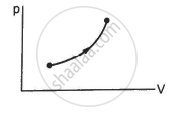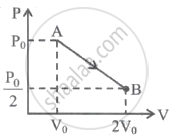Advertisements
Advertisements
Question
A uniform tube closed at one end, contains a pellet of mercury 10 cm long. When the tube is kept vertically with the closed-end upward, the length of the air column trapped is 20 cm. Find the length of the air column trapped when the tube is inverted so that the closed-end goes down. Atmospheric pressure = 75 cm of mercury.
Solution
Let the CSA of the tube be A .
Initial volume of air , V1 = 20A cm = 0.2A
Length of mercury , h = 0.1 m
Let the pressure of the trapped air when the tube is inverted and vertical be P1.
Now , Pressure of the mercury and trapped air balances the atmospheric pressure . Thus ,
P1 + `0.1rho g` = `0.75rho g`
⇒ P1 = `0.65rho g`
when the tube is inverted with the closed end down , the pressure acting upon the trapped air is
Atmospheric pressure + Mercury column pressure
Now ,
Pressure of trapped air = Atmospheric Pressure + Mercury column Pressure [In equilibrium]
P2 = `0.75 rho g` + `0.1rho g` = `0.85 rho g`
Applying the Boyle's law when the temperature remains constant , we get
P1 V1 = P2V2
Let the new height of the trapped air be x .
⇒ `0.65 rho g`0.2A = `0.85rho g`xA
⇒ x = 0.15 m = 15 cm
APPEARS IN
RELATED QUESTIONS
Estimate the fraction of molecular volume to the actual volume occupied by oxygen gas at STP. Take the diameter of an oxygen molecule to be 3Å.
An air bubble of volume 1.0 cm3 rises from the bottom of a lake 40 m deep at a temperature of 12 °C. To what volume does it grow when it reaches the surface, which is at a temperature of 35 °C?
A gas in equilibrium has uniform density and pressure throughout its volume. This is strictly true only if there are no external influences. A gas column under gravity, for example, does not have the uniform density (and pressure). As you might expect, its density decreases with height. The precise dependence is given by the so-called law of atmospheres
n2 = n1 exp [-mg (h2 – h1)/ kBT]
Where n2, n1 refer to number density at heights h2 and h1 respectively. Use this relation to derive the equation for sedimentation equilibrium of a suspension in a liquid column:
n2 = n1 exp [-mg NA(ρ - P′) (h2 –h1)/ (ρRT)]
Where ρ is the density of the suspended particle, and ρ’ that of surrounding medium. [NA is Avogadro’s number, and R the universal gas constant.] [Hint: Use Archimedes principle to find the apparent weight of the suspended particle.]
Calculate the mass of 1 cm3 of oxygen kept at STP.
An electric bulb of volume 250 cc was sealed during manufacturing at a pressure of 10−3 mm of mercury at 27°C. Compute the number of air molecules contained in the bulb. Avogadro constant = 6 × 1023 mol−1, density of mercury = 13600 kg m−3 and g = 10 m s−2.
Use R=8.314J K-1 mol-1
Consider a sample of oxygen at 300 K. Find the average time taken by a molecule to travel a distance equal to the diameter of the earth.
Use R=8.314 JK-1 mol-1
The ratio Cp / Cv for a gas is 1.29. What is the degree of freedom of the molecules of this gas?
Work done by a sample of an ideal gas in a process A is double the work done in another process B. The temperature rises through the same amount in the two processes. If CAand CB be the molar heat capacities for the two processes,
For a solid with a small expansion coefficient,
The value of Cp − Cv is 1.00 R for a gas sample in state A and 1.08 R in state B. Let pAand pB denote the pressures and TA and TB denote the temperatures of the states A and B, respectively. It is most likely that
70 calories of heat are required to raise the temperature of 2 mole of an ideal gas at constant pressure from 30° C to 35° C. The amount of heat required to raise the temperature of the same gas through the same range at constant volume is
The figure shows a process on a gas in which pressure and volume both change. The molar heat capacity for this process is C.

The molar heat capacity for the process shown in the figure is

The molar heat capacity of oxygen gas at STP is nearly 2.5 R. As the temperature is increased, it gradually increases and approaches 3.5 R. The most appropriate reason for this behaviour is that at high temperatures
A sample of an ideal gas (γ = 1.5) is compressed adiabatically from a volume of 150 cm3 to 50 cm3. The initial pressure and the initial temperature are 150 kPa and 300 K. Find (a) the number of moles of the gas in the sample (b) the molar heat capacity at constant volume (c) the final pressure and temperature (d) the work done by the gas in the process and (e) the change in internal energy of the gas.
One mole of gas expands obeying the relation as shown in the P-V diagram. The maximum temperature in this process is equal to ______.

